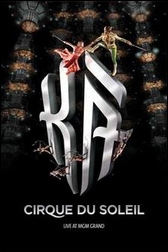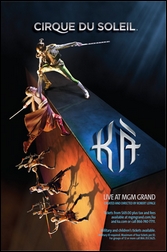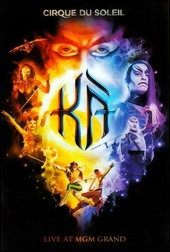|
Évolution & Visuals
| Milestone | Date |
| Name Registered | 01/30/2004 |
| Press Conference | 09/15/2004 |
| Lion's Den #1 | 11/06/2004 |
| Lion's Den #2 | 11/12/2004 |
| Previews Begin | 11/26/2004 |
| Gala Premiere | 02/03/2005 |
| 2,000th Show | 02/18/2009 |
| 3,000th Show | 03/23/2011 |
| 4,000th Show | 04/20/2013 |
| 5,000th Show | 06/xx/2015 |
| 6,000th Show | 08/23/2017 |
| COVID Hiatus | 03/14/2020 |
|
Cirque planted what it called a “Flower in the Desert” with Mystère in 1993, and then
watched its newly-formed garden bloom when it launched “O” in 1998 to enormous success. The
two shows would come to dominate The Strip, setting Cirque du Soleil as the King of
Entertainment in Las Vegas. But Cirque wasn’t done yet. Two years after Mirage Resorts and
MGM Grand merged (to form MGM-Mirage), plans to expand Cirque’s presence on The Strip were
announced with not just one, but two new shows! The first, Zumanity, premiered in 2003 at
New York-New York Casino-Hotel, the second – KÀ - for the MGM Grand would replace “EFX Alive!”
starring Rick Springfield, would open in 2004 – Cirque du Soleil’s 20th Anniversary year.
Robert Lepage was set as director with Guy Caron (Le Magie Continue, Dralion) serving as
Director of Creation. The show was set to "shake the spectator's perception of space,
conception of the law of gravity, and comprehension of the world in three dimensions."
These projects built upon the relationship between Cirque du Soleil and MGM-Mirage, which
started back in 1992 with a special presentation of "Nouvelle Experience" on the grounds of
the Mirage hotel-casino. "MGM Mirage has an excellent grasp of the creative strengths and
energy that drive Cirque du Soleil," said Guy Laliberté, CEO and Founder in the press release
for the dual projects. "We have always held fast to our dream of reinventing other forms of
entertainment." And it certainly looked as if Cirque du Soleil would continue to "Re-invent
the Circus" in the desert of Las Vegas, and worldwide, as their expanded partnership with MGM
Mirage globalized their efforts even more. The race was on...
[ Évolution •
Visuals ]
Defying the Laws of Gravity
By the end of 2002 speculation ran wild regarding just what Cirque had up its
sleeve. Casting calls became rare windows into just what the company had in mind,
leaking out small details about the performances/acts under consideration for each.
The MGM Grand show, slated to debut sometime in 2004, was looking for artists skilled
in Archery and the Martial Arts -- Wu Shu, Kung Fu, and Akido with the ability to use
a Sabre, Nunchakus or Katana. From the moment the casting calls went out we knew this
show would be completely different from Mystère, “O”, or the NewYork-NewYork show.
The show (then going by the working title of “Duality”) was described as a "fantastic
epic [that] will shatter space perception and defy the laws of gravity, with a story
based on duality, personified by twins who will illustrate the battle that life forces
us to wage against ourselves." This description of the show is nothing new however, and
has been discussed in fandom before. Certain details regarding what we may see in the
show have remained a mystery only to crop up on the casting site. Such tidbits include
that the show would feature "acrobatic dance, martial arts, puppets, music, singing and
Cirque du Soleil's acrobatic savoir-faire". Wait, puppets?
Yes, Cirque is placing its acrobatic "savoir-faire" (know-how) in the hands of
Robert Lepage, who is directing the show, and Guy Caron (Dralion), the Director of
Creation. What is interesting, however, is that information about some of the
characters we'll see in the show has come to light -- the Evil Counsellor and the
Blind Man: The Evil Counselor is the principal character in this new show. He's
described as a "poisonous character and [a] power-hungry manipulator (like
Shakespeare's Iago or Richard III)." The Blind Man is also a principal character,
old, wise, and will personify an African wizard.
* * *
It was in London in the summer of 2000 that Cirque du Soleil founder and CEO Guy
Laliberté bumped into Lepage, the experimental Québécois film and stage writer and
director. The pair had been flirting with collaboration for years.
"Cirque du Soleil and I had kind of this on and off relationship forever," Lepage says.
"We worked with the same people. They keep stealing my technicians and emptying Quebec
of anybody who has talent," he says with a laugh. When Cirque du Soleil founder Guy
Laliberte offered him "Ka," Lepage balked, took a week to think about it, then called
back and declined. "I'm not sure I can do this. It's such a huge thing. My process is too
organic for you guys," he told them.
But Laliberte cited his two tours, saying "it's obvious that you can control a chaotic
environment, that you can make sense of it. (The concerts were) more than just
razzamatazz. That's where we want to go." He asked Lepage to re-create the same
dreamlike feeling with a thread of a story line. "I'd say even though it's a huge
megashow, it is a very shy attempt at that. It's a first step (for Cirque du Soleil)
into trying to tell a story and have some kind of logical order," Lepage says. "It
is a complete change of mentality for Cirque du Soleil. It looks like a trivial
thing, but it's actually radically different for them."
Set more or less in 17th-century Japan, the show tells the epic, broad-brush tale
of Imperial twins, a boy and a girl (played by two sisters from San Francisco).
Separated during a storm at sea -- an 1,800-pound boat subjected to vertiginous
rocking by the actors -- the twins must endure trial and tribulation before finding
reunion. It's a story line any vacationing farm family from Indiana will understand.
The project's original working title was Feu (Fire), which encompassed for Lepage the
paradox of creation and destruction. "It gives us light and heat but also pain and
death," he said in an interview yesterday. " Ka, in fact, is also one of the Japanese
words for fire." The implicit duality was reflected in the ancient Egyptian notion of
Ka, the spiritual essence that was said to accompany physical beings through the
journey of life.
To be sure, the decision to impose plot gave Laliberté some pause. As Lepage
explains it, "I told Guy that if he wanted narrative, he had to have conflict. And
of course what Cirque is about is peace and harmony and Zen balance. So when we showed
him some martial-arts demonstration tapes early on, he went, 'Whoah. That's not
Cirque. I don't think we can do this.'" Later, he changed his mind, but encouraged
Lepage and his creative team -- including British stage and rock-show designer Mark
Fisher and American puppeteer Michael Curry -- not to emphasize the conflict. For
Lepage, that mild restraint was more than offset by the virtually unlimited budget
and the generous time -- almost three years in the end --needed to conceive, design,
cast, train and rehearse.
But there was also some discord.
{ Read More }
One of the most important aspects of putting a show together is its creative team. During
the “Dragone Era” (1990-1999), the creative team remained relatively the same – the same lighting
specialist, the same sound designer, the same make-up designer, etc. Upon Franco Dragone’s
departure, most of that team decided take a break as well (or broke away from Cirque du Soleil
to follow Dragone). So for 1999’s Dralion and 2002’s Varekai, many of the creators were new or
upcoming specialists who hadn’t worked with Cirque before. So when Cirque decided to up-the-ante
in Las Vegas with two new shows it wanted a few veterans to join the creative process.
One of those creative veterans was composer Benoit Jutras, who composed music for Le Cirque
Réinventé, Fascination, Mystère (with René Dupéré), and Quidam, “O”, La Nouba and Journey of
Man (solo). He was brought on board the Cirque 2004 project early on; however, he left a year
into the assignment citing “creative differences”. Cirque then turned to René Dupéré (who said
when he left Cirque following 2004’s Alegría that he’d be interested in composing a score for
a non-big top show), who joined the project and composed the score for KÀ.
What those creative differences were have never officially been discussed; however, in a
2011 interview Fascination did with Mr. Jutras he did say he’d been working on the project
for a year before leaving “in a mutual parting of the ways.” We also asked if any of that
music had been used in other venues. His reply: “Yes, actually. I did reuse a few pieces for
Le Rêve and The House of Dancing Water. The main theme for The House of Dancing Water was
originally created for KÀ. And there were two other pieces but [I only used] the ribs [of them].
I’m writing so close to the image most of the time that it becomes difficult to reuse the
music. If I can I just reuse a few bars or the main theme. René has more of a tendency to write
songs so it’s easier to move. My structures are shorter and so close to the action that when you
take out the action it just doesn’t make sense anymore.”
René Dupéré’s score for KA incorporated a symphonic orchestra of 57 musicians and a choir
of over 40 singers, making KÀ Cirque du Soleil’s most ambitious recording to date. And
performing that music would also be one of Cirque’s ambitious undertakings. The orchestra is
sampled and synched to a live (hidden) band during performances and piping that music to
patrons took on new levels: every seat in the KÀ Theater has two speakers built into its
headrest, which allows sound effects to be targeted, manipulated and customized to any of
the theater’s 16 seating zones. Talk about an undertaking!
On September 15, 2004, Cirque finally announced the show to the world via a press
conference held at the MGM Grand in Las Vegas. In the days after the official word had
been released there were copious amounts of buzz regarding the announcement, in both
media and fan circles. So much so that a plethora of questions had arisen regarding
the production and sometimes those answers weren’t forthcoming. They certainly weren’t
for this writer, who was quite preoccupied out of his home country — in the city of
Kyoto to be exact — embarking on the second phase of a trip to Japan. I recalled with
clarity eyeing the announcement as I read my email messages at K’s Backpacker’s House
with curiosity, asking myself... what was this KÀ really all about? In Issue #38 –
October 2004 – Fascination explored several of these questions.
Q. What does KÀ mean?
A. According to Wikipedia, in Egyptian mythology it is written the human soul
is made up of five distinct parts: the Ka, Akh, Ba, Shadow and the Name. The Ka,
therefore, is the spiritual soul of a person, existing in tandem with the living
being and continuing throughout the afterlife. Readers with knowledge of the Japanese
language may also recognize the word “ka,” a particle, which is used to change a
statement sentence into a question and for comparisons, among other things. That
concept was also reflected in the show's visual signature, which evokes the central
theme of duality as personified by the twins and the symbolic use of fire. The logo
was said to be influenced by Asian iconography. Fans may be interested to know that
KÀ’s working title was “duality”.
Q. What is KÀ about?
A. KÀ is all about duality, or the concept of twins. It is that concept, one
of duality (“personified by the twins and the symbolic use of fire”), which is
reflected in the show’s vision and therefore transfers to the show’s title.
According to the Cirque press release, KÀ combines “acrobatic performances,
martial arts, puppetry, multimedia and pyrotechnics to illustrate the nature of
duality [and] tells the epic saga of separated twins-a boy and a girl-who embark
on a perilous journey to fulfill their linked destinies. As the plot unfolds, danger
lies in wait for them at every turn. Archers and spearmen hunt the twins relentlessly,
as their quest takes them through a succession of challenging landscapes, from
mysterious seashore through menacing mountains and foreboding forests.”
The show's creative elements are essential to invoking the world of KÀ. The
costumes for the international cast of 72 artists have an Asian influence, as
reflected in the lavish imperial court costumes and robust martial artists' warrior
uniforms. Additionally, the mood is set by the original score, which incorporates
soaring melodies and richly textured arrangements driven through an elaborate audio
system that literally surrounds the spectator in sound.
Another important element is the ambivalent power of fire to create and destroy.
"Fire is the one thing that holds everything together," says Lepage. "It's the
storyline and the saga. It creates conflict and destruction as it gives life and
light."
Cirque du Soleil Founder and CEO, Guy Laliberté, describes KÀ as "the most
theatrical show we've ever done." It is scripted with a strongly defined almost
cinematic narrative, with clearly identified characters and story arcs. The execution
of that narrative called for more technologically advanced visual effects than Cirque
du Soleil has ever attempted. "That's why I wanted Robert Lepage to write and direct
the show. With his vast experience in theatre and film, his knowledge of the technology
and his curiosity and innovative spirit, he was the only man for the job."
Q. How much did KÀ cost to produce?
A. According to the Las Vegas Sun, Cirque du Soleil spent $30 million to bring KA
to fruition. The MGM Grand spent $135 million on the theater, bringing the total price
tag to approximately $165 million US. To bring this number into perspective, it was
reported that it cost $66 million to produce Zumanity at the NY-NY Hotel/Casino, $90
million US cost for “O” at Bellagio ($70 million theater/$20 million production) and
$20 million plus for Mystère at Treasure Island.
Q. How many/what are the acts?
A. During the media preview at least one of the “acts” was presented, “The Wheel
of Death”. The Wheel is a remarkable looking contraption that seems more like a ride
that might be found on your local fair’s midway than in a Cirque du Soleil show. It
consists of two “wheels” attached at the end of two moving arms in which performers
climb into, around and on top to perform their feats of acrobatics.
The actual list of the rest of the “acts” has not been presented, however there
have been rumors. Such tidbits include that the show will feature “acrobatic dance,
martial arts, puppets, bungee aerial acts, and trampolines.”
Q. How many performers are in KÀ?
A. There are currently 72 performers assigned to KÀ.
Q. What is the KÀ Theater like?
A. Not too many details regarding the KÀ Theater have been released up to this
point, but suffice it to say the theater is a remarkable performance space. It sits
1,951 patrons and, as reported above, came at a cost of $135 million US.
"The arrival of KÀ is the crown jewel in the renaissance of MGM Grand," says Gamal
Aziz, MGM Grand president and COO. "Throughout our reinvention, we have strived for
the best in dining, entertainment and service. With the unveiling of KÀ, MGM Grand
is taken to a new level."
Previously the spectacular shows EFX and EFX Alive occupied that space, however,
if you’ve seen them and know the theater get ready for a shock — the space was totally
renovated and remade to specifically house KÀ. It is said there is no definable stage
as we know it. Instead the fixed stage has been replaced by “a fog-filled ‘void’” in
which platforms and riggings move in and out as needed.
“There are a lot of things that people will see that so far have been done only
in movies and television with special effects. Here it is for real,” said Guy
Laliberté. It’s “the most theatrical show we’ve ever done.”
Q. When does KÀ premiere?
A. Special preview performances begin on November 26, 2004 at 8:00pm. One show
per evening will be held from November 26th through December 7th, when a two show
per-night schedule will begin at 7:00pm and 10:30pm (though this may change). KÀ is
scheduled to perform Friday through Tuesday (Dark Wednesday/Thursday). Children under
five-years of age are not permitted into the theater and guests under the age of 18
must be accompanied by an adult.
# # #
With as many questions as could be answered before the show premiered we
waited... After a slight technical delay (the show was scheduled to premiere
on June 25, 2004, then July 9, 2004 - "They're not really problems, they're
obstacles," said director Robert Lepage. "In the Buddhist philosophy, obstacles
are your friends. We've made a lot of friends in this production.") KÀ is designed
to be 90-minutes long; however, according to production manager Stephane Mongeau,
the first run-through on October 11, 2004 took nine hours. "We stopped a few times,"
he mused. By October 24, 2004, the production came in just under three hours. The
November 5, 2004 run-through lasted two hours, as did the first "Lion's Den"
performance (a full run-through with the boss, Guy Laliberté) on November 6, 2004
(originally scheduled for November 5th). A second “Lion’s Den” on November 12, 2004
shaved off a few more minutes, "we did it in one hour and 45 minutes without stops,"
Mongeau said. Preview performances began on November 26, 2004 and later held its
official gala opening on February 3, 2005.
A few changes have come to the show since then. First, the removal of the
Pillars act (learn more by exploring KÀ here at Le Grand Chapiteau) – done so due
to the difficulties of presenting this act night-after-night, the injuries it has
caused and (as rumors suggest) at the behest of Robert Lepage who felt the act
did not ultimately fit into the story (although it has also been suggested that
the show needed to be trimmed for time and Pillars was the logical choice). Second,
a new visual identity (January 2007). And third, the addition of an aerial duet
featuring the firefly boy and the twin sister (November 9, 2007).
Since its debut, KÀ has been lavished with generally favorable and positive
reviews; however, if there’s been one negative comment regarding the production,
it’s leveled at the show’s stage. “The stage itself is the main star of the show,
overshadowing the performers and ultimately resulting in a weaker show.”
Never-the-less, the show has received the prestigious “Thea Award for Outstanding
Technical Achievement”, and continues to delight crowds night after night.
"It's show business. We're not making art here, we're making pleasure
and excitement. We're making escapism."
 |
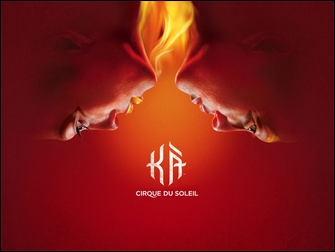 |
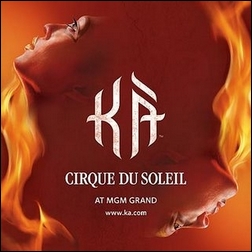 |
| {2004-2006} |
{2004-2006} |
|

![]()







